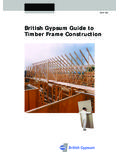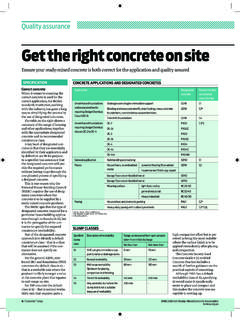Transcription of Thermal Insulation of Floors - Design for Homes
1 Dow Construction ProductsThermal Insulation of FloorsThis seminar covers the principles, Design and installation ofground bearing and suspended insulated Floors . You willdiscover Why a floor should be insulated How a floor can be insulated The general Design considerations including the relevant codesof practice, building and materials standards The "whys and wherefores" of Insulation selection How to rate the Thermal performance of a floor How to avoid Thermal bridging How to control moisture transfer through the floor The "dos and don'ts" of insulated floor installation How to renovate an old suspended timber ground floorDOW CONSTRUCTION PRODUCTS (a division of the Dow Chemical Company Ltd)
2 Thermal Insulation OF FLOORSW elcome to this RIBA approved CPD information about the Dow Chemical Company: US origin, 100 years old2nd largest chemical company in the worldProducts : chemicals, plastics, sales: 18 39,000 world-wide (Europe 7,200) Dow in the UKSTYROFOAM*, the blue extruded polystyrene foam Insulation fromDow, has been produced at Kings Lynn since Styrofoam range comprises: Floors - Floormate* 200,350,500 and 700 Cavity walls - Wallmate* CW Walls internally - Styrofoam IB Structures below ground - Perimate* DI Pitched roofs - Roofmate* PR, RL Inverted flat roofs - Roofmate SL, LG Conventional flat roofs - Deckmate* CM, FF*Trademarks of The Dow Chemical CompanyIntroductionThe aim of this seminar is to cover the principles.
3 Designconsiderations and installation of insulated Floors so that failureand subsequent business disruption (and possible litigation)can be avoided. 50 % of domestic floor failures are the fault of the builder rather thanthe designer (execution: 52%; Design /specification:30%; materials: 5%;other 13%) - BRE. floor (industrial, commercial, public) litigation accounts for 80% ofall litigation concerning buildings - structural engineering consultancy. Concrete floor failures are due to cracking, surface/finish failure anddetachment. Entrapped water (due to inadequate drying out of theconcrete base) is also a major contributor to failure - BRE.
4 Floors are difficult to repair and result in maximum disturbance to thebuilding occupants (domestic and business disruption). Floors are extremely sensitive to construction methods and practice. With the trend towards improved Thermal performance of buildings (seeproposed changes to Building Regulations Approved Document L June2000) there will be a corresponding increase in insulated Floors and in thethickness of the Insulation floor categories / types General Design issues Insulation issues Thermal performance Design & installation specifics Renovation SummaryWhat is a floor ? a construction providing the lowest horizontal surface in any space in a building.
5 A ground bearing floor will be the lowest in a Insulate ? 15 - 20% of total building heat loss is through the floor to improve internal conditions to eliminate Thermal bridging at floor /wall junctions and so reduce heat loss it reduces risk of condensation, the presence of which could damage adjacent materials mold formation on internal wall finishesThermal Insulation of floorshead to above floor (m)air temperature (0C) The graph below shows for a person standing about 1 metre from a wall the temperature can fluctuate as follows:- from floor to ceiling: 7 deg Cfrom feet to head: 5 deg CTemperature profile: floor to ceiling- uninsulated floorThermograph.
6 Room corner- uninsulated floor The temperature gradients measured at the floor /wall junction indicatethermal bridging. This causes excessive heat loss via the building fabric. Even if the U-value calculation for the floor indicates that there is noneed for Insulation it is recommended that a 1 metre wide horizontallayer of Insulation be positioned around the entire exposed will reduce/eliminate the Thermal bridge at the edge of the floorshown portGROUNDL ocation of floorGroundIntermediateExposedSemi-expos edTypeGround bearingSuspended(Note:1. Ground Floors can be ground bearing or suspended 2.)
7 Intermediate are always suspended)Materials of constructionConcreteTimberFloor categories & U-valuesUvalues W/m2 Kslipsheetinsulationscreeddamp proofmembrane DPMconcrete slabhardcore with sand blinding groundGroundbearing floor : typical build-upA groundbearing floor is used where the condition of the ground issuitable for supporting the floor slab. The slab is concrete (reinforced or non-reinforced) poured within, butseparate from the external walls (which have independentfoundations) (a reinforced concrete raft is an alternative type of ground bearingfloor - see later) DPM (damp proof membrane) can be located above or below theconcrete slab Insulation (rigid boards eg Floormate )can also be located below theslab - if so then the DPM should be positioned between Insulation andslab screed ( 75 mm min thickness) is sometimes referred to as a floating screed.
8 Note use of a slip sheet between Insulation andscreed, this also doubles as a vapour control layer (VCL) - min1200 gauge ( mm thick) polyethylene sheet recommended lapped150 mm and taped at joins and turned up at floor edgesalternative location forDPMDPC75 mm screedhardcore with sandbinding Insulation DPMreinforcedconcrete slabslip sheetwall foundationSuspended in-situ cast concrete ground floorGround floor slabs may be formed in-situ on to fill which is expected tosettle and is, therefore, regarded simply as temporary shuttering. Insuch cases the slab must be designed and reinforced as asuspended slab even though it is, initially, is best placed directly on top of the slab followed by the should not be positioned below the slab as it will drop awayfrom the underside when settlement sheetinsulationscreedDPMS uspended ground Floors suspended Floors are supported on the walls and comprise.
9 - concrete beams with block in fills- pre-cast concrete units- cast in-situ concreteor- timber joists & boarding some proprietary block and beam floor systems incorporateinsulation on the underside of the blocks 75 mm thick screed laid on top of block and beams and pre-castconcrete DPM between screed and Insulation must be continuous with theDPC slip sheet will act as a VCL (vapour control layer)BLOCK AND BEAMPRE-CAST CONCRETE board finishinsulationjoistboard finishinsulationjoistboard finishinsulationjoisttimber deckslipsheetTimber joist Floors are simple to install, avoid the need for large amounts of compactedbackfill and do not involve wet tradesThe Insulation boards (eg Floormate, Wallmate ) can be positioned: between joists attached to bottom of joists(but note that these may not be suitable solutions for a ground floor - it is essentialto maintain the space beneath for ventilation purposes) on decking (eg tongue & groove boarding ) laid over joists.
10 (note that the Insulation will not provide a suitable surface for the direct applicationof the floor finish. A slip sheet ( 500 gauge polyethylene sheet ) must be laid ontop of the Insulation . The Insulation should be overlaid with large rigid panels ofplywood or particle board ( preferably with interlocking edges) which will ensurethat high localised loads are uniformly distributed before installing the final compatibility of timber treatment used with the Insulation .)Note particularly the need for: underfloor void ventilation timber treatment concrete blinding over surface of floor void to avoid organic matter growth.






